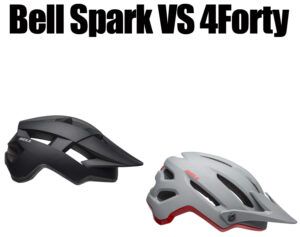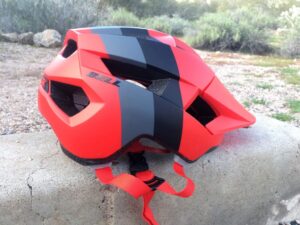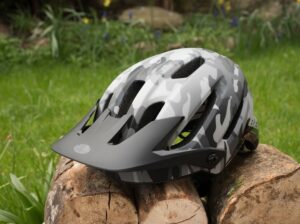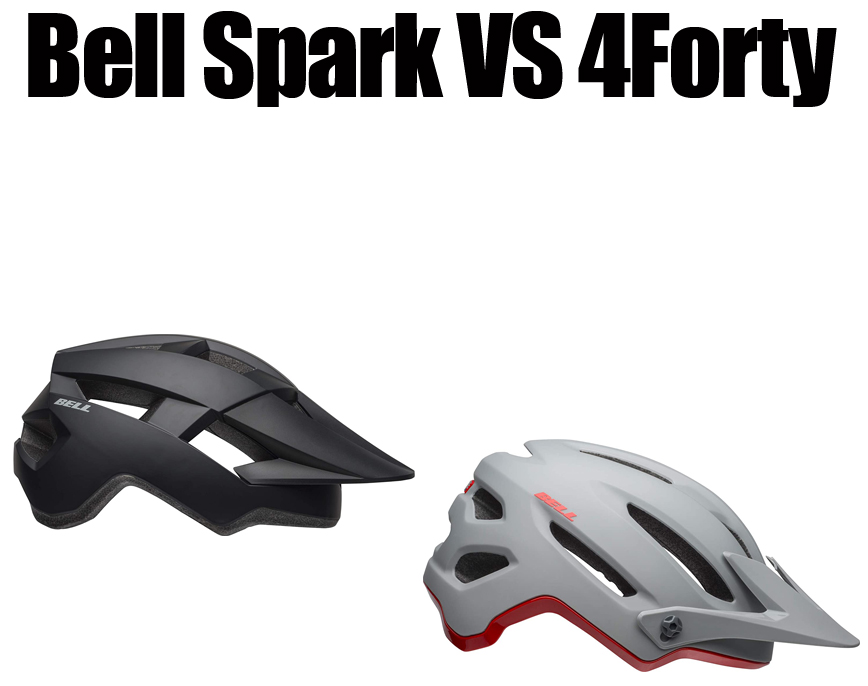Bike helmets are necessary because this safety gear can protect our head from the more serious impact and even protect our life. There are plenty to choose however, based on the riding discipline such as Bell Spark Vs 4Forty that are made for those who prefer to ride their bike on an uneven terrain or the trail. These helmets are comfortable and protective but not identical and if you wonder which to choose, let’s see what you can expect below.

In this comparison, we are going to talk about:
- Why Wearing a Bike Helmet
- What are Bell Spark and 4Forty
- How are the Design of Bell Spark and 4Forty
- How are the Build Quality of Bell Spark and 4Forty
- How are the Fitting of Bell Spark and 4Forty
- Are Bell Spark and 4Forty Comfortable
- Bell Spark Vs 4Forty
Cycling and Bike Helmets
We love being active and people may have different opinions on what they think of as an attractive hobby. Some people may prefer reading a book, watching their favorite show, cooking, making handicrafts, exercising, bicycling, etc. There are plenty to choose from based on what took your interest but bicycling is not just a hobby but can be an exercise and way to commute, especially if your destination is fairly close and can be reached using the vehicle. Read also: Giro Caden vs Sutton.
While the activity is pretty common and the bicycle itself has been around for so long, we still have to sustain the same risk of injury when riding the vehicle. The road that gets very crowded in modern days also makes it not as safe as it used to, moreover with the increasing amount of people and various vehicles used by people in modern days. This is why it is necessary and in some places even mandatory to always wear the helmet when riding a bike or scooter and similar tools.
Helmets are very simple, the way they work is by covering our skull from receiving a more serious impact. Of course there are arguments that they won’t properly cover the damage or they are not as effective, that wearing one or not doesn’t really give the advantage. But, depending on the riding discipline, there are also bike helmets with a fuller enclosure such as those made for downhill riding or racing because this type of activity bears a higher risk of injury.
Bicycling itself is a fairly safe activity if done properly or done in a more controlled place such as a separate lane made for cyclists. But, the fact is not all cities have the proper access for the facility which makes cyclists have to use the same road as motorbike, cars, and many other private or public transportation. This may increase the risk of safety for cyclists and compared to just wearing a helmet, the risk of getting severe head injury is not worth experiencing.
The way helmets protect our head is by both covering the surface and reducing the impact happening to the skull. The outer layer is covering the skin and direct contact to solid objects that may cause open wounds to the head, especially if there are sharp edges around. The soft foam inside will bridge the hard impact and reduce the overall energy transferred to the skull as well as spreading it to a wider surface to prevent a single concentrated impact.
| Bell Spark | Bell 4Forty | |
|---|---|---|
 |  |
|
| Product Dimensions | 15 x 11 x 8 inches | 7 x 5 x 4 inches |
| Shipping Weight | 12.8 Ounces | 13.44 Ounces |
| Best offer | Check price | Check price |
About Bell Spark and 4Forty
For those who are not used to wearing a bike helmet this safety gear may seem uncomfortable and inconvenient, just like how masks were rarely used before the pandemic and, we can always try to get used to them with effort. To properly find a perfect helmet that will be comfortable for you, make sure that they can fit well or based on the head circumference. Their fitting type is also important because there are helmets with better fitting adjustment.
The proper helmet must fit well and be made for the type of riding you are in, so road helmets for cyclists who only ride their bike on the road an if you prefer the more extreme terrain, MTB is the type made for your application. Most bike helmets such as Bell are making a wide range of helmets for different types of disciplines so do check your favorite brand and see what they can offer. Chances are, they will have the ideal option for you too.
Bell also has the option for people who prefer to ride their bike on difficult terrain such as with the Bell Spark and 4Forty. These helmets are the favorite of many and this is not without a reason. Besides how attractive they are, these helmets are very protective since our biggest concern in extreme terrain is that we can fall off the bike anytime if not careful enough. There may be rocks or sharp edges around which can hurt your head.
Talking about a helmet, both Bell Spark and 4Forty are quite affordable but in comparison the Sparks is the more affordable choice and just like most products, price plays a huge role in the overall product quality. Bell helmets are all made with the proper certification according to the type of activity they are made for. The two will be equally protective but, the 4Forty is the one made with the better construction. They are also using different fitting and you may like one of them better.

Bell Spark and 4Forty Design
Before moving further, let’s see the helmets and while being very much the same to typical MTB helmets from various well-known brands out there, they are also not identical. The bike styling is often a buying decision because we want the one that looks cool or attractive on our head and personal taste matters too. In comparison, the Spark has lots of larger air windows than what you can find on 4Forty which makes the former looks very cool to ride with.
The design of Spark is also more prominent in our opinion with sharp lines that makes the helmet looks attractive as a sporty gear while on the other hand 4Forty is more streamlined and smooth looking. We can’t say that these helmets are light because they are not and side by side the 4Forty is the heavier one at 380 grams compared to 365 grams of Sparks. In addition, the Spark is only available at universal size and universal XL while 4Forty has smaller size from S to XL.
Bell Spark and 4Forty Build Quality
Now for the most important part, let’s see what Bell Spark and 4Forty can offer starting from the build quality first. Just like most helmets, they are made using the in-mold method with a polycarbonate shell bounding the EPS foam liner on the inside. This process is seen as the more effective way to create helmets since it can improve the build quality and also help the helmet to be lighter compared to the older mechanism. The difference is Spark uses less of this polycarbonate to cover the foam.
Since the helmet has large air windows, the amount of shell used to cover the foam is also lessening and the concerning part is, there is plenty of exposed foam on the outer rim of the helmet in which it is already covered in 4Forty. It is not affecting the certification or protective ability but will be less sturdy for prolonged use because the foam is soft so it may chip or dented when transferred or stored and experience some stress.

Bell Spark and 4Forty Fitting
Moving further, let’s see the fitting system of Bell Spark and 4Forty which is also different. Starting with the Spark, since this helmet only has universal sizes, it can be a bit inconvenient for users with smaller heads. The fit of this helmet is rather loose for the smaller heads but should work well for the medium and larger ones, moreover it has the universal XL as well. The fitting adjustment is called Ergo Fit with a rear dial to adjust the liner inside but there is no option to adjust the height.
On the other hand, your 4Forty is available in a wide range of sizes as well as has a different fitting system using Float Fit with rear cradle which is located slightly lower on the back of the head compared to Spark. The issue is this thin plastic cradle can be a bit uncomfortable as they are fastened but, in comparison to Spark, the system allows for height adjustment. What to note is the fit can be highly subjective so it is not a guarantee that the helmet will be more comfortable for all riders.
Bell Spark and 4Forty Comfort
Lastly we want to talk about the comfort of Bell Spark and 4Forty because they are also quite different here. The Spark has 13 large rectangle vents all over the helmet and this works really well. The only problem is the padding is pretty thick so it can store sweat and sometimes it leaks too. The 4Forty also works really well despite the smaller windows, probably because it has a proper placement. Overall both helmets are comfortable and should not be an issue in terms of cooling ability.
Bell Spark vs 4Forty
There are plenty of MTB helmets that you can find out there and these two are similarly good options. In our opinion you will spend for 4Forty for its built quality because the helmet is well-made and properly covers the foam inside which is great to make sure it will last longer unless you hit it with a serious impact. The fitting system can be subjective but both have their own pros and cons while for the cooling ability they are very similar.
Conclusion
There is no bad option between the two so it is great to choose based on which seems to fit you the most but, if you can spend the budget, we highly recommend getting the 4Forty for its build quality and overall performance.
